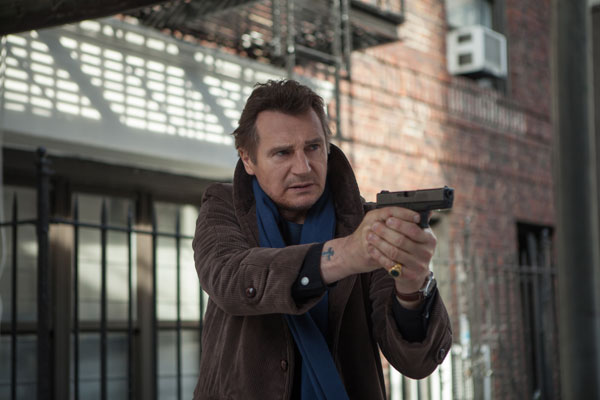Scott Frank’s “A Walk Among the Tombstones”—based on the
book series by Lawrence Block--is essentially a classic private eye noir with a
much much bleaker outlook on life.
Most of the action takes place in 1999 and with headlines about Y2K splashed
all over the front pages of newspapers there’s already a high amount of
paranoia and anxiety looming in the air. The perfect atmosphere for a tense neo
noir.
If the lines between good and evil were blurry in the noirs
of the 40’s and 50’s, --and even the Neo Noirs of the 70’s and 80’s-- those
lines are practically invisible in “Tombstones.” With the exception of one
brief scene, cops—as well as any representations of the law—are nonexistent. Frank’s
picture consists of criminals in varying degrees doing business with one
another. While certainly not game changing or as complex as it thinks it is,
the film is well executed with only a few hiccups along the way.
One of those criminals is also our hero, Matthew Scudder
(Liam Neeson), an unlicensed private eye. “Unlicensed” is the key word there. The
P.I.’s of the past, played by Humphrey Bogart, Jack Nicholson and Eliot Gould,
were always formally known as P.I.’s. Their methods may have been questionable
but they were always licensed, they even had a formal office setup, sometimes
with a secretary. On the other hand, Matthew walks the streets, hands placed
firmly in his coat pockets, sporting nothing but an expired police badge. However,
this doesn’t make him any less good at his job. Like Bogart, Scudder is quick
witted—Frank gives Neeson some great, witty dialogue to work with—resourceful
and just plain cool. He may not always know what exactly is going on but in a
one on one situation he gets the upper hand.
Like the movie, Scudder acts deliberately, dealing with situations
in a relaxed, cautious manner. This is in contrast to the alcoholic Officer
Scudder we see in the opening scene. He shoots down three criminals attempting
to rob a bar—in a similar manner to Dirty Harry—but does so in a reckless
manner. Now sober and no longer a cop, Scudder is more careful, more
responsible, even though he’s still technically a criminal. This is the best
movie Neeson has been in in a long time; he plays Scudder with his usual gravelly
determination but the character is firmly planted in reality. He can still kick
ass, but he’s not some cartoon character like he was in the “Taken” movies that
can do ridiculous things. Nothing about “Tombstones” feels outwardly ridiculous
or out of bounds. It’s a dark film with very subtle undertones of humor but the
humor comes naturally from character and dialogue.
The central story
involves Scudder helping drug dealer Kenny (Dan Stevens) find the men that
kidnapped and killed his wife, and stop them before it happens again. Right off
the bat, Scott is testing our sympathies. Why should we side with a drug
dealer? You could say that the wife was innocent and didn’t deserve to die but
by marrying a drug dealer she must have known the risks involved. It turns out
that the two killers are a much worse breed of criminal. Rapists and killers
that target the loved ones of drug dealers. Who use old connections from a
federal agency to get the records of their victims. (Between this and Frank’s
reckless episode as a cop, the picture seems to have an extremely pessimistic
view of law enforcement and federal agencies). By the end, we still may not
feel sympathetic towards Kenny or the other drug dealers but we want to see
those two sadists pay and we want to see Scudder deliver their punishment. In the
world of criminals, the more detestable ones become the antagonists.
The only person who isn’t a criminal is TJ (Brian “Astro”
Bradley”) a homeless teen that befriends Scudder. Thankfully, Frank doesn’t
make TJ into a “boy in peril”—a common stock character for crime thrillers—but
instead Scudder’s loyal helper and only real friend. On top of that, Scudder
becomes a sort of role model to him. TJ spends a lot of his time in the library
and is well versed in those famous P.I.’s like Phillip Marlowe or Sam Spade—both
played by Bogart—and comes to view Scudder as a “real life” incarnation of
them. Newcomer Bradley does a fantastic job; more often than not he holds his
own against Neeson. Helping an unlicensed P.I. catch heinous killers isn’t the
healthiest, or most constructive hobby for a teenager but it actually keeps T.J
from getting into worse trouble or worse habits. In a world of criminals, the
least detestable ones become the heroes/role models for kids. Go figure.
Admittedly, the film’s ending is too drawn out. I have no
problem with that if there’s more to be revealed, story wise, but the mystery
in “Tombstones” becomes abundantly clear during the homestretch, so there’s no
need to drag it out. This is part of a bigger issue the movie runs into; often
times it tries to convince you it’s more elaborate and complex than it actually
is, which leads to some unnecessary narrative convolution. For all that
happens, the movie is fairly straightforward.
Even so, Frank’s picture is a very solid Neo Noir that
further muddles those lines between what’s right and what’s wrong. It’s also one
that choses to unfold gradually and uses action more sparingly. Two things that
can’t be said about Neeson’s recent cinematic outings. When he kicks ass in
“Tombstones,” it has more of an impact.

No comments:
Post a Comment